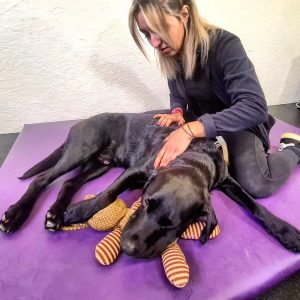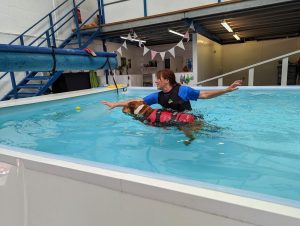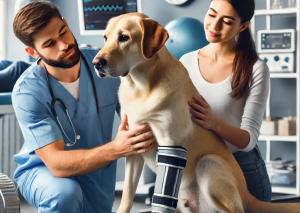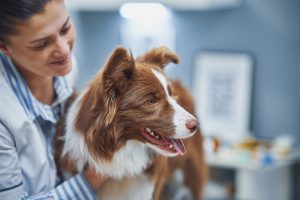At The Canine Fitness Centre, we’re passionate about proactive care, interdisciplinary collaboration, and personalised rehabilitation. But sometimes, the journey hits close to home. Our Managing Director’s own dog, Bertie, an 8-year-old Labrador Retriever, has recently undergone pioneering spinal surgery—and today, he begins his post-operative rehabilitation right here at the Centre.
This blog marks the first in a two-part series chronicling Bertie’s journey—from subtle early signs to diagnosis, surgery, and now the path to recovery. It’s a reminder of why surrounding yourself with a strong, skilled support team is absolutely vital—and why trusting your gut as an owner can make all the difference.
When Something Doesn’t Feel Right
Several months ago, Bertie began to show subtle changes—some creaking and clunking in his back, a slight reluctance on stairs, and eventually a more noticeably unstable pelvic limb gait. Given his existing elbow dysplasia and age, it wasn’t unreasonable for early suspicions to point toward hip dysplasia or spondylosis—as initially diagnosed by his excellent primary care team at Downlands Vets.
Physiotherapy began under that assumption, and for a time, things were manageable. But as the signs became more persistent—and more concerning—we decided to pursue advanced diagnostics rather than continue working from clinical assumptions. It was time for a second opinion.
Orthopaedics or Something More?
Bertie was referred to Dr Chris Jordan at The Moores Orthopaedic Clinic. As always, Chris was thorough and honest. His assessment? This wasn’t orthopaedic. In fact, despite his long history of elbow disease, Bertie was coping remarkably well with it. The problem clearly lay elsewhere—likely neurological.
That said, it wasn’t an unreasonable conclusion to initially suspect hip dysplasia; as Dr Colin Driver at Lumbry Park later explained, Bertie’s unusual gait could easily mimic proximal hindlimb lameness.
As a therapist myself, I choose not to assess my own dogs. It’s too easy to overthink or over-process, so I rely on my trusted network of skilled professionals—one of the best decisions I made throughout Bertie’s journey.
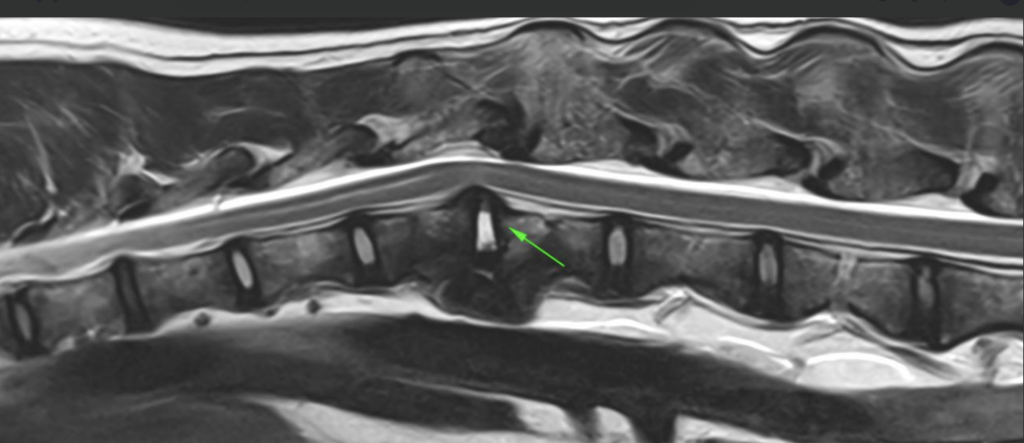
In this MRI image you can see how Bertie’s spinal cord is being compressed by the protruding disc.
The Neurological Turning Point
At Lumbry Park Veterinary Specialists, Bertie was assessed by Dr Colin Driver, one of the UK’s leading neurological surgeons. An MRI revealed the true extent of the issue:
- Severe T13–L1 intervertebral disc disease
- Spinal cord compression and canal stenosis
- Facet degeneration and vertebral instability
- Spondylosis deformans and spondylolisthesis
- Muscle changes indicating denervation and spinal cord inflammation
Without intervention, Bertie faced a high risk of losing his mobility—and eventually, his continence and quality of life.


The above images show the surgical construction to add structure and support to Bertie’s spine
Minimally Invasive, Maximally Effective
Dr Driver proposed a minimally invasive spinal stabilisation procedure, using percutaneous screws and rods under fluoroscopic guidance. Bertie is now among a very small number of dogs in the UK to receive this type of surgery—and Dr Driver is believed to be the only specialist in the UK currently performing it.
This approach offers reduced trauma, faster recovery, and even lower risk of infection—a huge advantage on top of Lumbry Park’s already exceptional clinical standards.

Bertie with Dr Colin Driver in his post-operative kennel at Lumbry Park
Outstanding Care, Every Step of the Way
Bertie underwent surgery on 23rd June, and the results were immediate. He was walking independently within 24 hours.
As an owner, I cannot overstate the support and communication from the entire team. Dr Driver and the nurses provided multiple daily updates, making me feel informed and reassured at every stage. A special thank you to Karyn from Curious Canine, who was part of Bertie’s care team and even took the time to email a heartfelt progress update—something that meant the world in a stressful moment.

3 days post surgery here’s Bertie on short walks to start his recovery
Just 3 Days After Surgery: A Remarkable Turnaround
Only three days post-op, Bertie’s progress is already inspiring:
- He can comfortably lift a leg to wee—something that used to cause unsteadiness.
- He’s able to defecate in one go again, now that pain in a crouch has been relieved.
- His walking is far more stable, although still a little wobbly.
- And most importantly—he’s happy, bright, and full of life. It’s hard to believe how much he was struggling just a few days ago.
Dr Driver is confident that Bertie’s coordination will continue to improve over the next six weeks, with a likely return to near-normal mobility.

Laser and Massage Therapy started 3 days post-operatively for Bertie at our Petersfield clinic
The Power of a Strong Care Team
Bertie’s journey underscores something we often tell clients: complex cases require a collaborative, multidisciplinary approach. His outcome was made possible by the seamless cooperation between his GP vet, orthopaedic specialist, neurologist, nurses, and rehabilitation team.
At The Canine Fitness Centre, we see the value of this model every day. No single person has all the answers—but the right team, working together, can change the course of a dog’s life.
What’s Next? Rehabilitation Begins
Today, Bertie starts his post-operative rehabilitation here at the Centre. He’ll receive a structured programme of physiotherapy, hydrotherapy, strengthening work, and ongoing pain management—designed specifically for dogs recovering from spinal surgery.
In our next blog, we’ll take you inside that process: what it looks like, how we measure success, and the science behind our approach.
Follow Bertie’s Story
We’re sharing Bertie’s journey not just as veterinary professionals, but as devoted dog owners who understand what it’s like to worry, hope, and heal alongside your companion.
If your dog is showing signs of instability, gait changes, or back pain—don’t delay. Early action and the right team can make all the difference.




